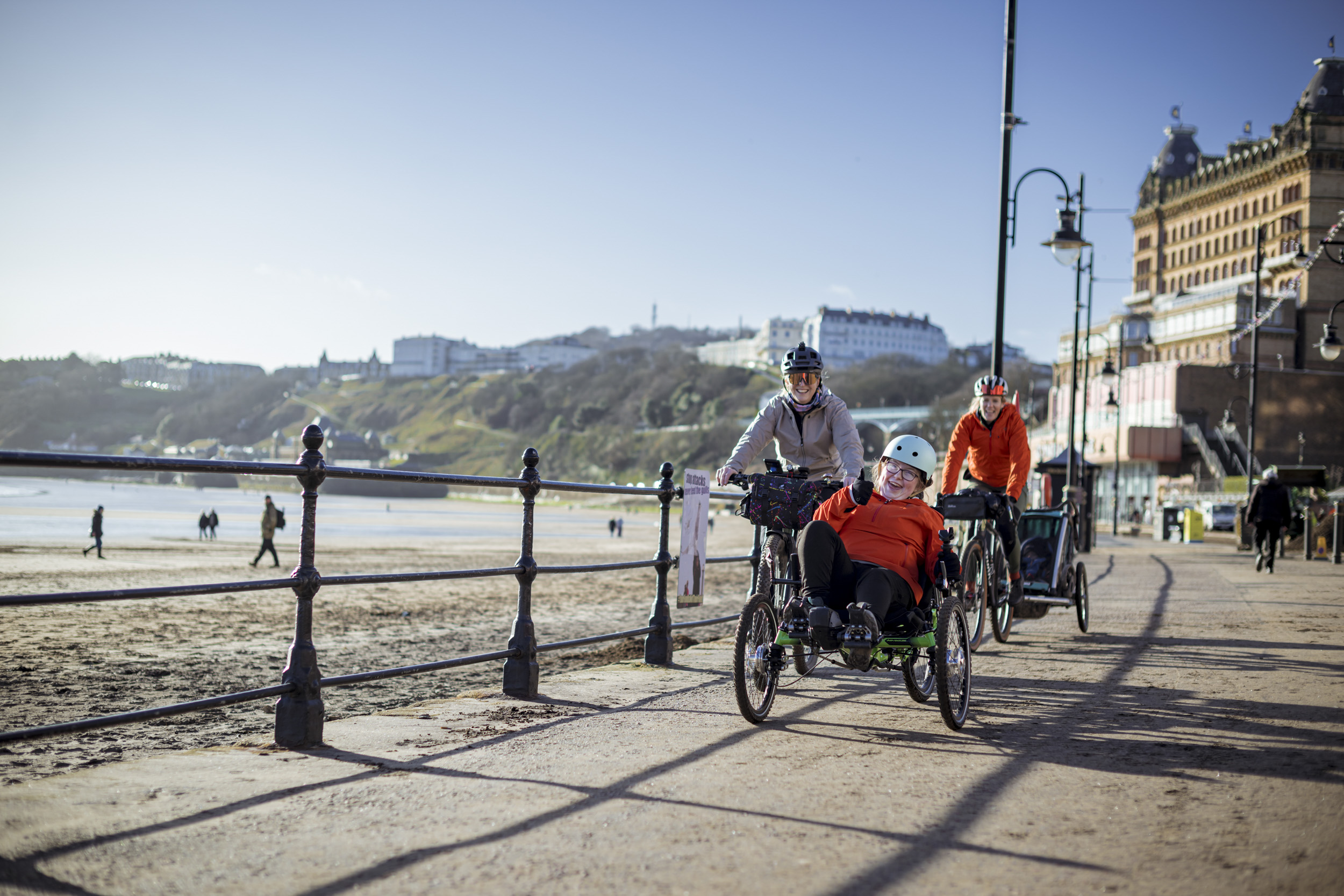Accessibility off-road doesn’t need to mean flat or easy, and challenges are not always physical. Vicky goes on a family ride that makes her rethink her understanding of accessible adventures.

Words Vicky Balfour Photography Emmie Collinge
After heading north for six hours, we’re making our way through the outskirts of Scarborough, when CeCe turns to me and asks: “Mum… what language do they speak here?” Granted, we’re born and bred Southerners living closer to Calais than London, but after I’d stopped trying not to laugh, I realised this question showed me she was engaging with our journey and thinking about where she was going – adding another piece to her understanding of the UK and her internal jigsaw puzzle of life.

Mums on (de)tour
We’re here to ride a taster section of a new bikepacking route around North Yorkshire, part of the Route YC project. Incorporating the Cinder Trail between Scarborough and Whitby and supported by komoot it had been an obvious choice for our now annual Bikepacking Mums trip with Kell Collinge and Phoebe Sneddon. Our first adventure with them was last year towing our three offspring in trailers around a frozen North Norfolk, while Monet Adams captured images that would become our award-winning film Along for the Ride. It sounds more glamorous than the reality, which is a group of friends pulling together to make sure they (and their children) make the most of their time outdoors. This year we had another layer of motherload as Phoebe’s daughter Sabine was riding with us and she and CeCe were going to be independent, untethered riders.
Latest Singletrack Merch
Buying and wearing our sustainable merch is another great way to support Singletrack
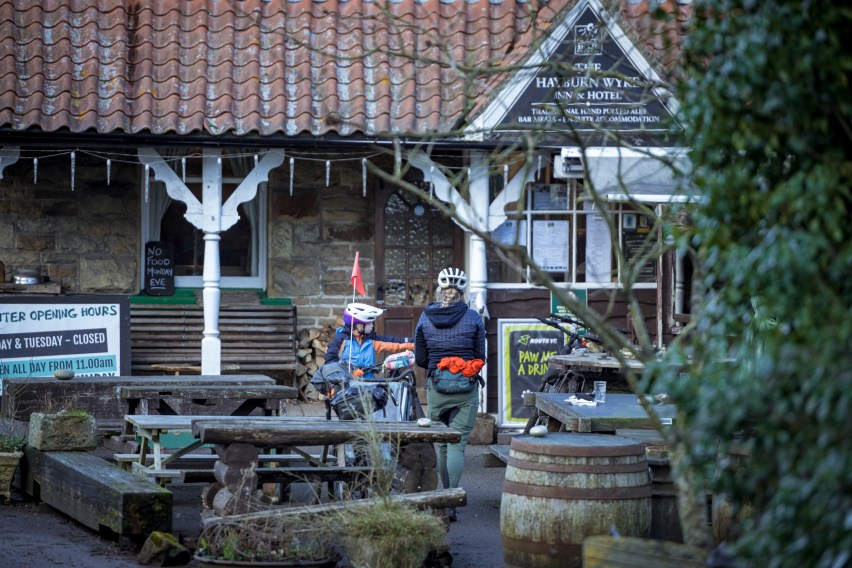
With our film and support crew of Monet, Emmie and Aiken we were a sizeable group spread across three tables in the Bike & Boot Inn in Scarborough. This overlooks a deep ravine where the road drops down to the sea, passing under a tall viaduct – a wide path cut down the hillside from the hotel to the seafront. While it was ‘accessible’, being smooth and off-road so cyclists could avoid traffic, I knew from experience that it would not be accessible for CeCe. Starting the day with a steep descent had the potential to exhaust her mentally and create anxiety before we’d had a chance to build any momentum. The easiest solution would be to drive to the bottom and unload our cycles ready to join the others. Any nerves were quelled as we smoothly adapted plans and remembered why we love adventuring together so much. The only aim for the trip was the greatest joy for the greatest number: no guilt, no pressure.

ICE road trikers
Of all the labels that have been assigned to CeCe, the one that feels most useful is ‘Global Developmental Delay’. And, of those three words, my favourite is ‘delay’. To me, it’s full of possibilities. Delay means just that – not at the same time or speed as the norm, it doesn’t mean there’s a finish line or a full stop. Ever. We don’t simply turn 18, leave education and stop developing, so why do we think young people with disabilities can’t continue to develop? Our lives are so much richer for learning new skills and many say the key to longevity is to keep playing with the neuroplasticity of our brains.
CeCe was riding a loaned ICE Adventure trike. This recumbent trike has two smaller wheels up front and a pair of joysticks left and right for steering and braking. The team at ICE fitted both brake hoses to a single lever on the left, so CeCe only had to think of ‘the brake’ rather than front and/or rear. Arguably the best thing about the trike (beyond stability, traction and the electric assist) is its enviolo automatic hub. For CeCe that’s a game-changer – we set the cadence using an app (usually about 60rpm) and the hub does the rest, shifting gears to ensure that she always comfortably pedals at 60rpm.
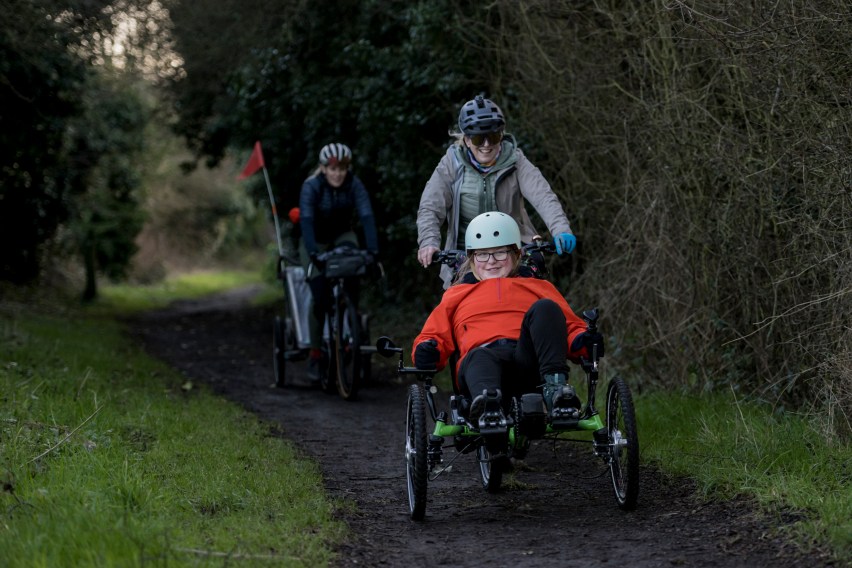
When CeCe first started riding independently on a traditional adult trike I soon realised that her biggest barrier was cognitive. Physically she is great at turning the pedals, but the combination of controlling speed and steering is more taxing than I’d ever considered. With electric assist, we could just about get away with a single gear on the flat but I felt deflated at the prospect of only ever riding on flat paths. With the automatic gear hub, CeCe can negotiate ascents without needing any understanding of how to change gears.
Parental anxiety
Weaving our way through some residential roads, we gained height as we climbed up from sea level. Turning left, the concrete slab road rises sharply to a junction with the main road. I could see Kell, Sabine and Phoebe in a tight group halfway up the hill as CeCe and I started to climb. I rode alongside CeCe, effectively boxing her in next to the kerb away from the cars. Funnelled between parked cars and the kerb on the climb I assumed that I’d be close to her on our way up the hill. But, before I knew it, CeCe was racing ahead as the Adventure trike shifted gears and increased motor support while she happily pedalled at 60rpm! By the time I caught up with her, my emotions had swung the full range. From the fear that I was being a reckless parent/cycling supporter by not being strong enough to keep pace alongside her, to the security of knowing that Phoebe, Kell or Monet would stop her racing into the main road ahead, and then sheer overwhelm at what CeCe had just achieved. As I pulled up alongside her I could see the glassy glint in her eyes and sensed her holding her breath – classic signs she was about to burst into tears. Worried that she was scared I leaned over to check she was ok and she said: “I can’t believe I just did that. I cycled up the road on my own.”
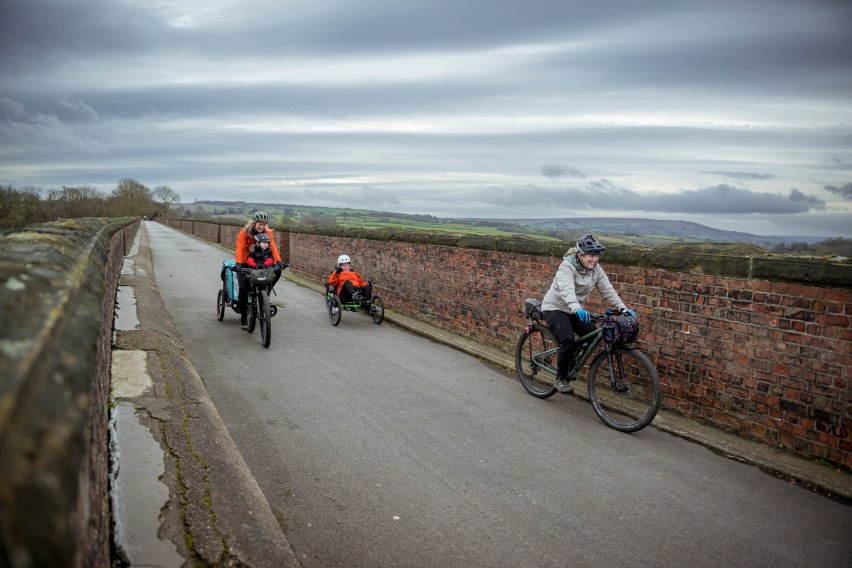
Skills acquisition
Ahead lay a staggered pair of fences covering two-thirds of the cycle path with a gap for riders and walkers to slalom through. Except we couldn’t – they were too close together so I had to get off and help CeCe perform a frustrating and complex three-point turn. Stubbornness alone prevented me from unloading CeCe and wheeling the bike around. Thankfully, it was the last such obstacle we found that day. From there on the barriers were placed to discourage motorbikes or stop errant children colliding with traffic, but wide enough for larger, longer machines to negotiate. As CeCe’s understanding of the bike grew, and with vocal instructions and cheers, she began to learn how to navigate them solo. By the time we reached the third chicane, she had it nailed.

After clearing the suburbs we eventually joined the unmade section of the Cinder Track. In midwinter, after a wet autumn, some sections were rutted and deep gullies had appeared in places. CeCe’s visual impairments mean that she doesn’t have any depth perception, which has always made transitions between surfaces difficult. Often I’d hear one of the others calling out to help her navigate and overcome her instinct to simply stop because she wasn’t sure it was safe to continue. As we made our way along the track I could almost see the connections in CeCe’s brain firing. Where half an hour earlier we’d had to explain which line to take, suddenly she was neatly negotiating the obstacles in the trail with a huge grin on her face. Just like the fence gates earlier in the ride and the hills in town, the trail didn’t have to be entirely smooth, flat and obstacle-free to be accessible to her. If it had been she wouldn’t have had the chance to develop her skills and confidence.
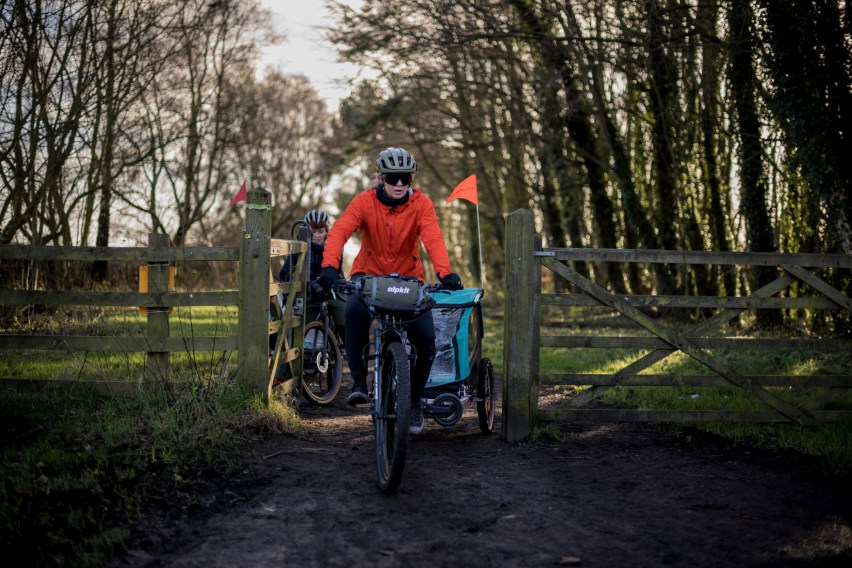
We reached Cloughton by mid-afternoon and CeCe was mentally and physically exhausted. She had achieved so much and had the self-awareness to say ‘no more’. In a matter of minutes, we’d removed the seat, folded the trike and she was in the passenger seat of Aiken’s car ready to head off and meet us at The Hayburn Wyke Inn where we would end the day with tea and chips.
New definitions
That night we sat around at our Airbnb reflecting on our day.
“Do we think the route is accessible?” Kell asked.
“I’m not so sure. Towing a trailer over some of those washed-out sections required quite a lot of experience and bike handling confidence. I’d worry about saying it’s completely accessible…”
“But those wide open gates were a dream!” I replied.
This was the point at which I really began to question what ‘accessible’ means and whether we should be aiming for more than just ‘accessible routes’. The further I travel in this landscape of CeCe’s independence the more I realise that it is as subtle and nuanced as she, and every other disabled person, is.
Up till now, I’ve just accepted that ‘accessibility’ is what we should be aiming for. At times I would have argued that a sanitised, level and easy-to-navigate version of the outdoors was the goal. Now I see it is an element of the goal, but not the whole. We need a better way to describe accessibility so individuals and support workers can decide where they want to go and what challenges they want to face. The right kind of accessibility is an enabler of development, but it also takes compassion and flexibility to make the most of those opportunities. With the right tools, the right support and choice, there’s no limit to what we can all achieve.
Adventures like this one remind me precisely why this is so important for ourselves and our young people. They remind me that it’s important to visit new places, it’s OK to change plans, to cut things short, to get a lift if you need to. But also if you try scary things, often they are OK, and even more often you find them easier the second time around. Ultimately, if we don’t challenge ourselves we don’t develop, and development is good for all of us.
The route they rode was part of the Route YC Cinder Track: komoot.com/tour/1380158494
Full Route: komoot.com/tour/1380150943
More information on the ICE Trike Adventure: icetrikes.co

